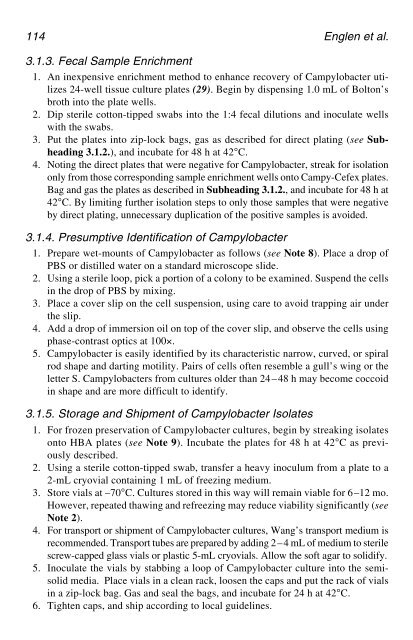PCR Detection of Microbial Pathogens PCR Detection of Microbial ...
PCR Detection of Microbial Pathogens PCR Detection of Microbial ...
PCR Detection of Microbial Pathogens PCR Detection of Microbial ...
Create successful ePaper yourself
Turn your PDF publications into a flip-book with our unique Google optimized e-Paper software.
114 Englen et al.<br />
3.1.3. Fecal Sample Enrichment<br />
1. An inexpensive enrichment method to enhance recovery <strong>of</strong> Campylobacter utilizes<br />
24-well tissue culture plates (29). Begin by dispensing 1.0 mL <strong>of</strong> Bolton’s<br />
broth into the plate wells.<br />
2. Dip sterile cotton-tipped swabs into the 1:4 fecal dilutions and inoculate wells<br />
with the swabs.<br />
3. Put the plates into zip-lock bags, gas as described for direct plating (see Subheading<br />
3.1.2.), and incubate for 48 h at 42°C.<br />
4. Noting the direct plates that were negative for Campylobacter, streak for isolation<br />
only from those corresponding sample enrichment wells onto Campy-Cefex plates.<br />
Bag and gas the plates as described in Subheading 3.1.2., and incubate for 48 h at<br />
42°C. By limiting further isolation steps to only those samples that were negative<br />
by direct plating, unnecessary duplication <strong>of</strong> the positive samples is avoided.<br />
3.1.4. Presumptive Identification <strong>of</strong> Campylobacter<br />
1. Prepare wet-mounts <strong>of</strong> Campylobacter as follows (see Note 8). Place a drop <strong>of</strong><br />
PBS or distilled water on a standard microscope slide.<br />
2. Using a sterile loop, pick a portion <strong>of</strong> a colony to be examined. Suspend the cells<br />
in the drop <strong>of</strong> PBS by mixing.<br />
3. Place a cover slip on the cell suspension, using care to avoid trapping air under<br />
the slip.<br />
4. Add a drop <strong>of</strong> immersion oil on top <strong>of</strong> the cover slip, and observe the cells using<br />
phase-contrast optics at 100×.<br />
5. Campylobacter is easily identified by its characteristic narrow, curved, or spiral<br />
rod shape and darting motility. Pairs <strong>of</strong> cells <strong>of</strong>ten resemble a gull’s wing or the<br />
letter S. Campylobacters from cultures older than 24–48 h may become coccoid<br />
in shape and are more difficult to identify.<br />
3.1.5. Storage and Shipment <strong>of</strong> Campylobacter Isolates<br />
1. For frozen preservation <strong>of</strong> Campylobacter cultures, begin by streaking isolates<br />
onto HBA plates (see Note 9). Incubate the plates for 48 h at 42°C as previously<br />
described.<br />
2. Using a sterile cotton-tipped swab, transfer a heavy inoculum from a plate to a<br />
2-mL cryovial containing 1 mL <strong>of</strong> freezing medium.<br />
3. Store vials at –70°C. Cultures stored in this way will remain viable for 6–12 mo.<br />
However, repeated thawing and refreezing may reduce viability significantly (see<br />
Note 2).<br />
4. For transport or shipment <strong>of</strong> Campylobacter cultures, Wang’s transport medium is<br />
recommended. Transport tubes are prepared by adding 2–4 mL <strong>of</strong> medium to sterile<br />
screw-capped glass vials or plastic 5-mL cryovials. Allow the s<strong>of</strong>t agar to solidify.<br />
5. Inoculate the vials by stabbing a loop <strong>of</strong> Campylobacter culture into the semisolid<br />
media. Place vials in a clean rack, loosen the caps and put the rack <strong>of</strong> vials<br />
in a zip-lock bag. Gas and seal the bags, and incubate for 24 h at 42°C.<br />
6. Tighten caps, and ship according to local guidelines.






